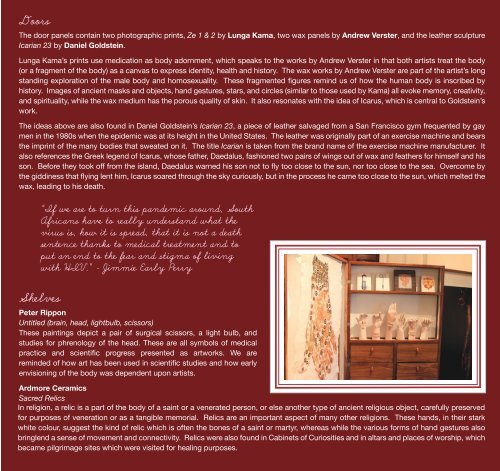The Andy Warhol Foundation for the Visual Arts - Carol Brown ...
The Andy Warhol Foundation for the Visual Arts - Carol Brown ...
The Andy Warhol Foundation for the Visual Arts - Carol Brown ...
You also want an ePaper? Increase the reach of your titles
YUMPU automatically turns print PDFs into web optimized ePapers that Google loves.
Doors<br />
<strong>The</strong> door panels contain two photographic prints, Ze 1 & 2 by Lunga Kama, two wax panels by Andrew Verster, and <strong>the</strong> lea<strong>the</strong>r sculpture<br />
Icarian 23 by Daniel Goldstein.<br />
Lunga Kama’s prints use medication as body adornment, which speaks to <strong>the</strong> works by Andrew Verster in that both artists treat <strong>the</strong> body<br />
(or a fragment of <strong>the</strong> body) as a canvas to express identity, health and history. <strong>The</strong> wax works by Andrew Verster are part of <strong>the</strong> artist’s long<br />
standing exploration of <strong>the</strong> male body and homosexuality. <strong>The</strong>se fragmented figures remind us of how <strong>the</strong> human body is inscribed by<br />
history. Images of ancient masks and objects, hand gestures, stars, and circles (similar to those used by Kama) all evoke memory, creativity,<br />
and spirituality, while <strong>the</strong> wax medium has <strong>the</strong> porous quality of skin. It also resonates with <strong>the</strong> idea of Icarus, which is central to Goldstein’s<br />
work.<br />
<strong>The</strong> ideas above are also found in Daniel Goldstein’s Icarian 23, a piece of lea<strong>the</strong>r salvaged from a San Francisco gym frequented by gay<br />
men in <strong>the</strong> 1980s when <strong>the</strong> epidemic was at its height in <strong>the</strong> United States. <strong>The</strong> lea<strong>the</strong>r was originally part of an exercise machine and bears<br />
<strong>the</strong> imprint of <strong>the</strong> many bodies that sweated on it. <strong>The</strong> title Icarian is taken from <strong>the</strong> brand name of <strong>the</strong> exercise machine manufacturer. It<br />
also references <strong>the</strong> Greek legend of Icarus, whose fa<strong>the</strong>r, Daedalus, fashioned two pairs of wings out of wax and fea<strong>the</strong>rs <strong>for</strong> himself and his<br />
son. Be<strong>for</strong>e <strong>the</strong>y took off from <strong>the</strong> island, Daedalus warned his son not to fly too close to <strong>the</strong> sun, nor too close to <strong>the</strong> sea. Overcome by<br />
<strong>the</strong> giddiness that flying lent him, Icarus soared through <strong>the</strong> sky curiously, but in <strong>the</strong> process he came too close to <strong>the</strong> sun, which melted <strong>the</strong><br />
wax, leading to his death.<br />
“If we are to turn this pandemic around, South<br />
Africans have to really understand what <strong>the</strong><br />
virus is, how it is spread, that it is not a death<br />
sentence thanks to medical treatment and to<br />
put an end to <strong>the</strong> fear and stigma of living<br />
with HIV.” - Jimmie Early Perry<br />
Shelves<br />
Peter Rippon<br />
Untitled (brain, head, lightbulb, scissors)<br />
<strong>The</strong>se paintings depict a pair of surgical scissors, a light bulb, and<br />
studies <strong>for</strong> phrenology of <strong>the</strong> head. <strong>The</strong>se are all symbols of medical<br />
practice and scientific progress presented as artworks. We are<br />
reminded of how art has been used in scientific studies and how early<br />
envisioning of <strong>the</strong> body was dependent upon artists.<br />
Ardmore Ceramics<br />
Sacred Relics<br />
In religion, a relic is a part of <strong>the</strong> body of a saint or a venerated person, or else ano<strong>the</strong>r type of ancient religious object, carefully preserved<br />
<strong>for</strong> purposes of veneration or as a tangible memorial. Relics are an important aspect of many o<strong>the</strong>r religions. <strong>The</strong>se hands, in <strong>the</strong>ir stark<br />
white colour, suggest <strong>the</strong> kind of relic which is often <strong>the</strong> bones of a saint or martyr, whereas while <strong>the</strong> various <strong>for</strong>ms of hand gestures also<br />
bringlend a sense of movement and connectivity. Relics were also found in Cabinets of Curiosities and in altars and places of worship, which<br />
became pilgrimage sites which were visited <strong>for</strong> healing purposes.


